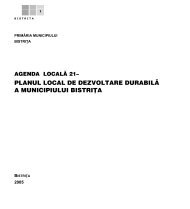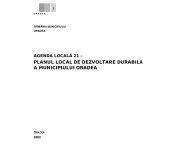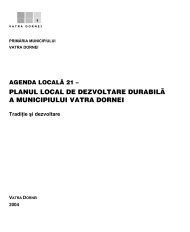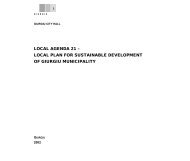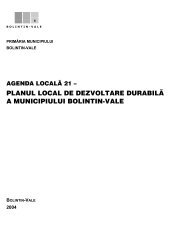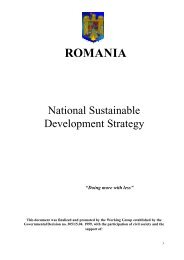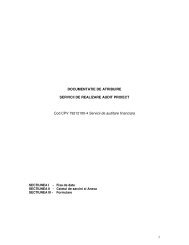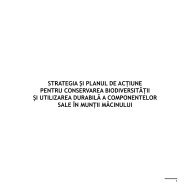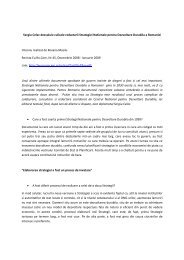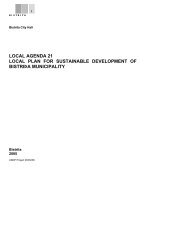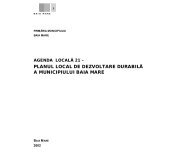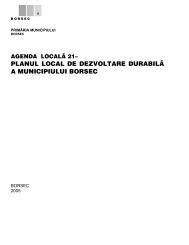Local Plan for Sustainable Development of Sibiu Municipality
Local Plan for Sustainable Development of Sibiu Municipality
Local Plan for Sustainable Development of Sibiu Municipality
You also want an ePaper? Increase the reach of your titles
YUMPU automatically turns print PDFs into web optimized ePapers that Google loves.
33<br />
SIBIU<br />
Furthermore, 3 more placement centres were taken<br />
over (from special schools in Dumbrăveni, Turnu Roşu<br />
and Mediaş) and the Pilot Centre <strong>for</strong> recovery and<br />
rehabilitation <strong>of</strong> the disabled youths in Tălmaciu; the<br />
last one became the Placement Centre no. 13.<br />
From their establishment until the present time, the<br />
administrative and organizing structure and the activity<br />
plan were trans<strong>for</strong>med according to the Governmental<br />
Strategy <strong>for</strong> protection <strong>of</strong> children in difficulty, and<br />
according to the county strategy.<br />
Family type alternatives were promoted instead <strong>of</strong><br />
those <strong>of</strong> residential type, the main objective being the<br />
protection <strong>of</strong> children in family environments, through:<br />
• reinstatement in the natural family and<br />
prevention <strong>of</strong> child abandonment by families<br />
at risk, by financial support from private bodies<br />
authorized to provide child protection and<br />
support adoption activities, and by projects<br />
financed by the National Authority <strong>for</strong> Child<br />
Protection and Adoption;<br />
• the establishment and development <strong>of</strong> a<br />
maternal assistance network, with authorized<br />
private bodies financing 70% <strong>of</strong> investments.<br />
As a result <strong>of</strong> the termination <strong>of</strong> international<br />
adoptions, the greater part <strong>of</strong> these bodies<br />
ceased to exist, the maternal assistants were<br />
taken over by <strong>Sibiu</strong> GDCRP. During 2001, the<br />
<strong>Sibiu</strong> GDCRP developed a programme<br />
financed by the National Authority <strong>for</strong> Child<br />
Protection and Adoption, to support and certify<br />
165 maternal assistants; at 5/1/2003, there<br />
were 260 certified pr<strong>of</strong>essional maternal<br />
assistants;<br />
• the increase in the number <strong>of</strong> the children in<br />
placement/ family type guardianship from<br />
121 children in 1998, to 485 by 5/1/2003;<br />
• the increase in the number <strong>of</strong> the children<br />
benefiting from alternative services (day<br />
centres, family or semi-family centres) provided<br />
STRONG POINTS<br />
A decrease in number <strong>of</strong> the entrances in residential type<br />
institutions.<br />
An increase in number <strong>of</strong> the children under care in family<br />
type protection system.<br />
A decrease by 50% <strong>of</strong> the number <strong>of</strong> children in the<br />
residential system until 2007, depending on the development<br />
<strong>of</strong> community services.<br />
by authorized private bodies. The increase was<br />
from 137 children in 1999, to 286 in 5/1/2003.<br />
• the establishment <strong>of</strong> the Complex<br />
Evaluation Service <strong>for</strong> disabled children, at<br />
3/1/2002. The functions <strong>of</strong> the Board <strong>for</strong><br />
Complex Evaluation and School and<br />
Pr<strong>of</strong>essional Orientation were taken over by the<br />
Board <strong>for</strong> Child Protection, according to HGR<br />
no. 1205 in 04.12.2001. A number <strong>of</strong> 2,044<br />
children with special needs were evaluated by<br />
12/1/2002, <strong>for</strong> whom were issued resolutions,<br />
certificates <strong>for</strong> assessing the handicap degree,<br />
school and pr<strong>of</strong>essional orientation certificates.<br />
A personalised service plan was made <strong>for</strong> each<br />
evaluated child. At 12/1/2002, the re-evaluation<br />
was started.<br />
• the establishment <strong>of</strong> Programmes, projects<br />
Service in 3/1/2003.<br />
In 5/1/2003, 1,843 children were under care, <strong>of</strong> which:<br />
• 41% (751) children under residential type care:<br />
- in institutions with over 12 children/building -<br />
513 (68%);<br />
- in institutions with over 100 children – 238<br />
(32%);<br />
• 44% (806) children in alternative services:<br />
- maternal assistance/simple placement –<br />
777;<br />
- guardianship <strong>for</strong> adoption – 12;<br />
- other services (emergency reception centre)<br />
– 17<br />
• 15% (286) children under OPA care, as a result<br />
<strong>of</strong> a placement measure took by the Child<br />
Protection Board, in family or semi-family type<br />
centres. At present, in OPA there are also 5-<br />
day centres with 150 places.<br />
WEAK POINTS<br />
The change in the law framework and law discrepancies.<br />
The local community does not participate in supporting the<br />
established objectives. Poor budget.<br />
The social phenomenon dynamics influenced by the family<br />
socio-economic status.



